
In today’s competitive market, it’s hard to leave a mark online. It’s not just the small business that struggles. Even big companies battle to succeed with poor strategies or no proper plans.
The customer is king, and you need to retain them to run a successful business. In today’s world, digital marketing has changed a lot. Today you cannot just rely on SEO to get relevant traffic to your website. To succeed online, you need qualified traffic and leads that convert.
Content has taken center stage in the field of digital marketing. There are bleak chances that your business will survive online without targeted content marketing.
Are you one such business frustrated with not being able to market your business successfully? If yes, it’s time to re-evaluate your content marketing strategies.
According to the Content Marketing Institute, 84% of B2C marketers successfully created brand awareness through content marketing. At the same time, 61% succeeded in generating leads. This is why more businesses are now focusing on their content marketing strategies.

According to the same report by CMI, 59% of B2C marketers expect larger budgets for content marketing in 2020 than they had in 2019. At the same time, fifty percent of the respondents want to improve the audience’s quality and conversion through content.
In the current scenario, content marketing is the life and soul of any online business, and without a proper strategy in place, your success largely depends on chance.
This guide will tell you how to create a killer content strategy for your eCommerce blog.
But first, let’s see why content marketing is essential for your business.
Why is Content Marketing Crucial?
Content marketing is the best way to introduce your company to the world, drive relevant traffic, generate business, and build trust with potential customers.
All businesses face tough competition to win the attention of a handful of people that we call customers. With the world population close to 8 billion, you might wonder why we refer to customers as just a handful.
Well, firstly, different businesses have diverse audiences. You cannot market your products or services to everyone. There will be just a few people requiring your products or services at a particular moment, leaving you with a small number of prospects. And remember, many companies like you are striving to get their attention.
So, how do you win over your customers?
To win your audience, you need to build a brand. And how would you build a brand online? Well through unique content. You can’t lure your customers with empty pages and boring sites.
You need content that resonates with your company’s ideas and educates or helps your customers with their pain points.
However, before you sit down to strategize your content marketing, you need to answer three questions:
- Who is your target audience?
- What will they benefit from it?
- What is your company’s objective?
We’ll help you answer these questions in detail in the following steps on how to create a killer content strategy for your business-
1. Define your goals
The success of any strategic plan depends on how strong the foundation is.
The first step to creating a content strategy is to define your goals. Without clear goals, you won’t be able to determine what kind of content you want. Moreover, you won’t have any parameters to compare your results with.
First, you need to ascertain why you even need a content strategy in the first place. To know ‘what’ kind of content your business needs, you need to know ‘why’ you need it.
Is it to-
| Increase traffic on your website? | Improve SEO for better traffic? | Boost conversions? | Improve your brand name? | Educate your customers? |
| Per experts, content marketing is one of the best ways to direct high-quality traffic to your website. | High-quality content can improve your Search engine optimization. When you design content around the most targeted keywords, the chances of getting better traffic increase manifold. | Content planned according to customers’ requirements helps you bring genuine buyers to your website. | Relevant and high-quality content allows you to communicate what your brand stands for, its ideologies, and its vision to your customers, thus helping you build a strong image and create brand awareness. | When you plan content to educate your audience or help address some of their pain points, you’ll ensure they keep returning to your site. |
Let’s take an example-


This is leafly.com’s about us page. It defines the audience (people looking for science-based information, licensed brands, and retailers). Highlights what the audience gets from this site (cannabis information, strains, products, and legal, licensed retailers). And state their objective- to get licensed brands and retailers closer to their customers.
Once you know what you expect your audience to get out of your site, you can formulate your business goals.
2. Define your KPIs
To measure your success, you need to define key performance indicators (KPIs).
KPIs allow you to recognize areas of improvement and measure what you achieve through content marketing.
Take the KPIs as milestones for your achievements. These milestones are crucial because, without them, you’ll be lost and wouldn’t know if your efforts, time, and money paid off.
These should include your goals in terms of sales, revenue, SEO, traffic, etc.
- Your quarterly, monthly, or annual revenue targets
- Increase in site traffic and customer retention by a certain percentage
- Improve search ranking of the pages you want to promote, also known as key pages.
- Get a specific number of likes, shares, or comments for your main pillar pages.
3. Create buyer personas
To create relevant content, you need to know your audience. Until you clearly understand who your buyers are and their needs, you won’t be able to develop appropriate content.
A buyer’s persona is a research-based fictional profile you create for your ideal customers. Who are they? What are their likes and dislikes? What are they looking for? Etc. Making a buyer persona helps you better understand your audience. Many marketers even name their buyer personas as individuals.
You’ll have to conduct surveys, interviews, or talk to your audience to create a customer or buyer’s persona. A typical persona would help you get the following information-
- Demographic details– Gender, Age, Location
- Occupation details– Responsibilities, job title, income, industry
- Pain Points– the most significant problem they need to solve.
- Interests- What they seek, their desires, and what makes them tick
- Preferences– In what form do they like the content? Podcasts, stories, videos, etc.?
- Online behaviors– What do they look for? What kind of keywords do they use? How do they search and buy?
Once you know your buyer persona, you can easily create content that resonates with their wants and needs.
Let’s understand this through an example. Suppose you have a cannabis business and want to make your buyer persona. You deal in CBD products, primarily topicals and oils, but you are clueless about your target customers. In this case, how would you market your products, and to whom?
It would interest you to know that according to newfrontierdata.com, there are nine types of cannabis consumers. Their research is based on consumers’ habits, demographics, and preferences.
But among these nine types, under which category does your audience fall? To know that, you’ll have to create your buyer personas.

To create buyer personas, you can follow the steps below-
Start with a template
First, you need to create a template and fill in the relevant headings based on the details you want to gather.
A typical template could be as follows-
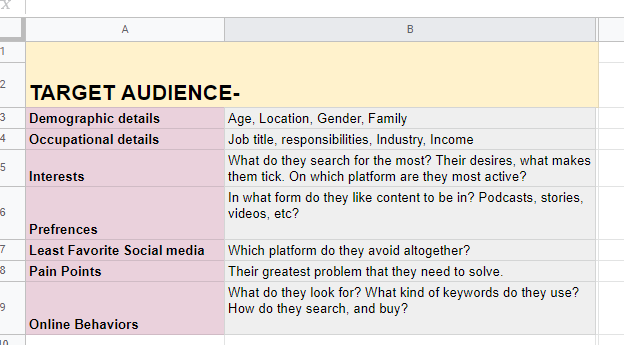
Once your template is ready, you need to fill in the details.
And how would you do that?
There are various ways to collect the details. Read on to find out
Conduct Interviews/Surveys
The best method to gather accurate information is by asking precise questions. You can conduct surveys or direct interviews with your-
- Already Existing Customers
- Prospective Customers
- Your Target Customers
- Previous Customers
Get in touch with your sales team
You might have underestimated this, but your sales team can be a sea of information. They are the ones who deal directly with customers and prospects. They can provide relevant information on the questions they get and the challenges customers face.
With their help, you can understand your buyer’s needs and pain points.
Be active on social networks
Social platforms are the most valuable tools for knowing your customers. Use these platforms to understand how your customers feel about you, what they say, etc. It’s also an excellent platform to engage your target customers directly and ask them questions.
Use various tools and business data
Tools like Google Analytics can provide in-depth insights into your customer behavior.
Go to – Audience- Interests-Overview. Here you’ll find the segments your visitors fit into-
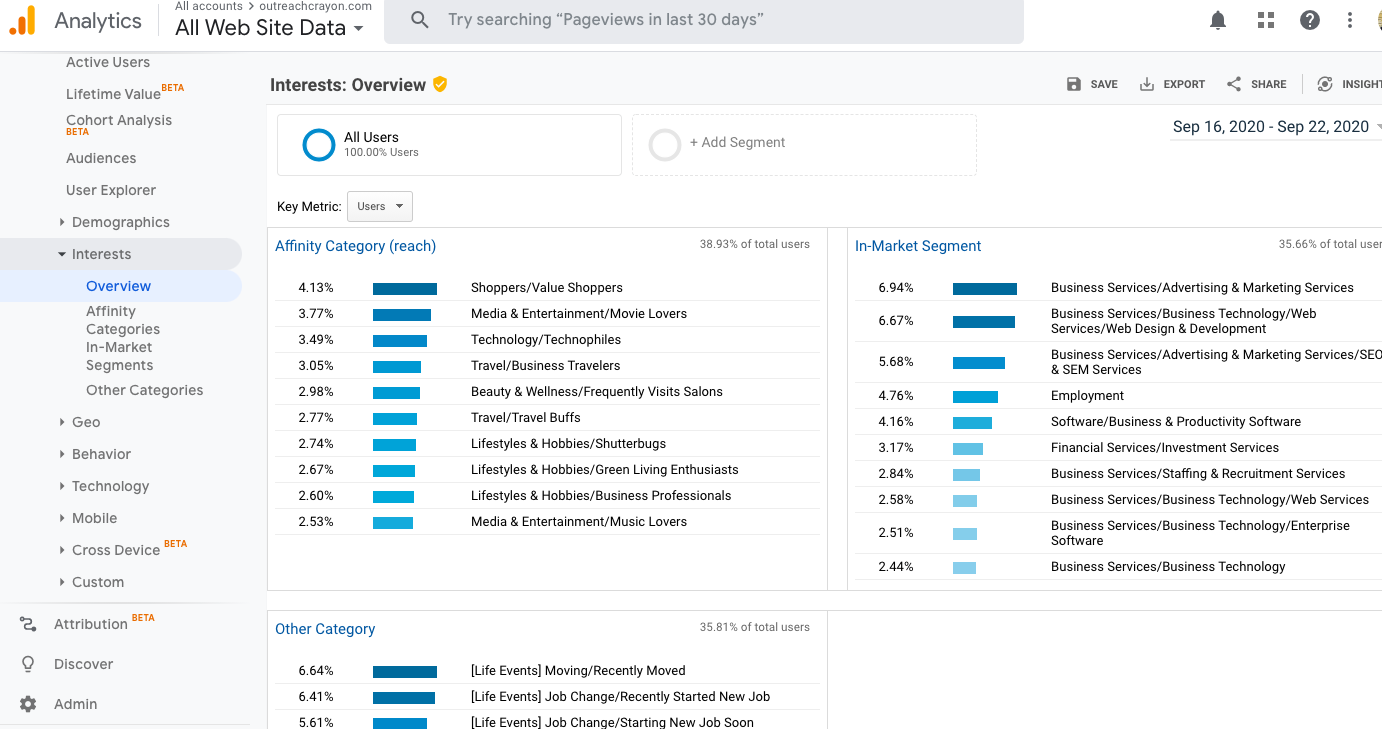
Similarly, you can get helpful insights from your social media as well.
For instance, you can find demographic details on Facebook via Facebook page insights.
Study Competitor’s websites-
It may surprise you, but your competitors can offer valuable insight into your target audience. Your competitors will target the same customer niche as you, and you can learn much from their data.
Various tools can help you study your competitors’ web presence. One exciting tool is Alexa’s Audience Overlap Tool.
Enter your competitor’s website URL and hit the Find similar websites button.
This will create an exciting map of sites that share the same audience as your competitors. You would know on what platforms your target audience is most active through this.
4. Audit your content
Most businesses already have a lot of content. So before formulating your content strategy, you must audit the existing content.
Analyze content on your social media, blog, videos, podcasts, etc.
To do this, you need to-
- Start with a sheet and log all your blogs, guest posts, etc.
- Assess if they are helpful and have user engagement
- Identify loopholes or shortcomings.
This is the perfect time to analyze your competitor’s content.
Log your content-
Various tools can help you do this. The Screaming Frog is one of the most popular tools to analyze your content and fix SEO mistakes.
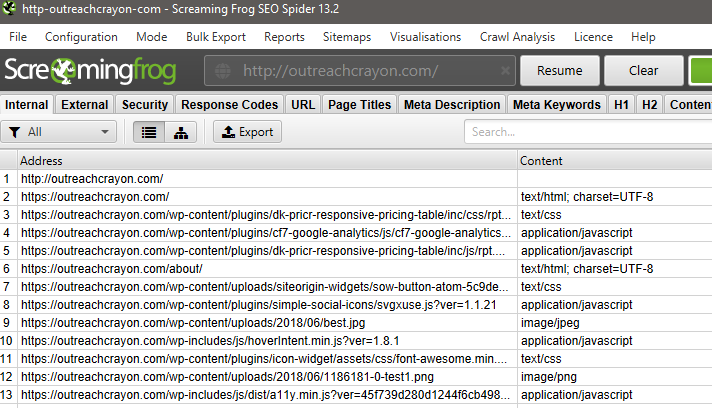
It’s a site crawler that will-
- List URLs
- Include redirects and broken links
- Find duplicate content
- Check titles and descriptions
- Create interesting sitemaps
To begin with, download its free version and crawl up to 500 URLs.
Some of the alternatives to Screaming Frog are SEMRush, Ahrefs, Moz Pro, and SEO Powersuite Website Auditor.
Check its effectiveness
Once you have all the details on a spreadsheet, you need to check your existing content’s effectiveness.
You should look for the following metrics-
- Pieces with inbound links to the content
- Search rankings for targeted keywords
- Most popular content
Keeping these parameters in mind, you can determine which content is acceptable and which needs modifications.
SEMRush Position tracking tools and site audits are valuable tools for checking these parameters.
Identify Shortcomings
The last step of the content audit would be identifying the gaps or areas that can be improved. You might find out –
- High-ranking keywords relevant to your niche that you are not working on or targeted keywords that do not rank well on the search engine
- Customer queries that you might have missed.
- Content that can rank well with some modifications.
A popular tool to identify such gaps is Ahrefs.
With this tool, you can find out how your keywords are ranking and even analyze your competitor’s keywords ranking well on search engines.
Go to organic search, enter your URL—select Content Gap.
The following window will appear-
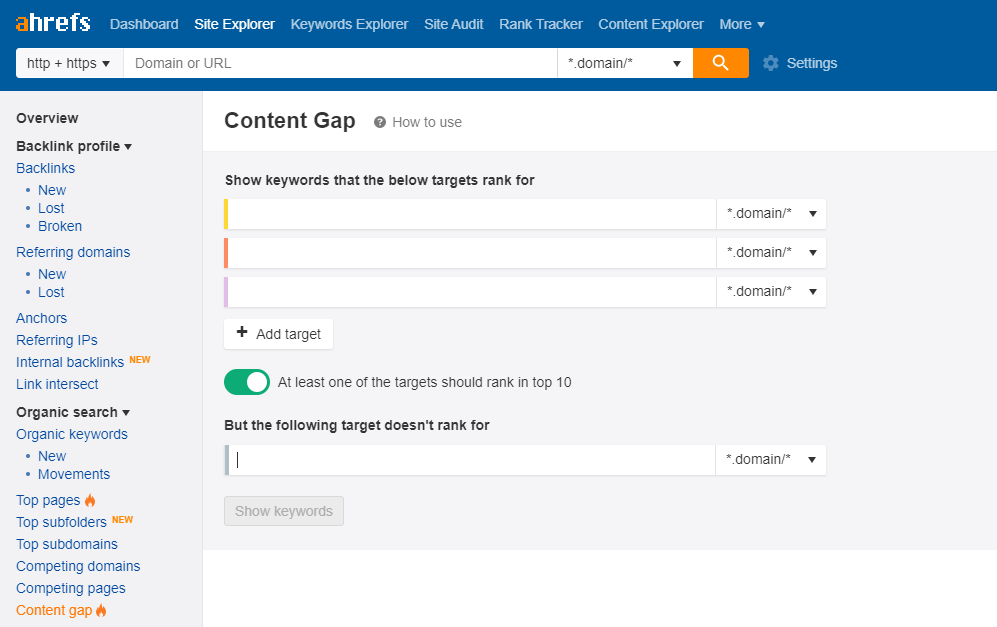
Enter your competitor’s URLs under Show keywords for which any of the below targets rank. Enter your URL below, But the following target does not rank for, and hit the Show Keywords button.
You’ll get a list of your competitor’s high-ranking keywords that you can focus on now.
5. Determine the best platforms
After much research on your target audience, you will get a fair idea of their favorite platforms. You’ll want to be present on the platforms where your target audience is most active.
You might find some channels where you already hold a strong position and your target audience is also active. These are the platforms you need to focus on more. Engage with your audience, listen to their needs, and drive relevant traffic to your site.
You need to build a strategy to engage new leads and gradually build a successful presence on channels you are not active on.
You can use Google Analytics to ensure the platforms where your audience is most active and sharing your content.
Another great tool to find this data is BuzzSumo. It gives valuable content insights through exciting charts.
6. Choose content types
Now that you have figured out the channels your audiences hang out on, you need to decide on the type of content you should create to engage them.Content can be in various formats- articles, videos, podcasts, etc.
Typically, almost every business relies on blog posts or e-commerce blogs. Having valuable, actionable, and shareable content on your website allows you to reshare and repurpose them on other sites.
Although high-quality blogs are essential for your website, to be successful, you need a mix of content right for your audience on different channels.
Tools like Buzzsumo can help you understand the types of content you should create to boost social networks’ reach and engagement.
Besides Blog Posts, some other forms of content that you should focus on are-
- Video Marketing– Videos garner the attention of audiences of almost all age groups. Videos are very efficient in engaging viewers and promoting your brand. According to Wyzowl, 81% of businesses using video marketing saw a drastic increase in sales, whereas 99% of people/businesses said they would continue to use video content in 2020.
Videos can be informative, educational, tutorials, or explainer videos. It’s an effective way to explain your product and services to the masses.
- Infographics– Who doesn’t love good graphics and easy-to-understand information?
Infographics are one of the best ways to creatively present your product or services. Two reasons you can’t ignore infographics are – they are easy to understand and attractive. They are easily linkable and shareable. The best part is that you can easily convert your existing blog into a stunning infographic with tools like Picktochart and Canva.
- Podcasts– A podcast is content in audio form that allows you to talk to your audiences directly.
In today’s busy lifestyle, podcasts offer people an easy way to listen to what they love on the go. It’s easily downloadable on a mobile device or computer. Hence, if you are using podcasts for content marketing, you need to know what intrigues your targeted niche. If you already have some exciting videos your customers like, you can repurpose them and use their audio as a podcast.
Podcasts have been rapidly growing in popularity. According to Podcast Insights, 51% of the US population listened to podcasts in 2019. 49 % of people listened to podcasts at home, while 22% while in the car.
Check out the infographic below for some interesting statistics on podcasts-

- Image Marketing– With an ever-shrinking customer attention span, image marketing is a must-have in your content marketing arsenal. Exciting images can quickly grab customer attention and have an incredible retention rate.
According to Visual Capitalist, every internet-minute user shared 3,47,222 posts on Instagram in 2020. This number was just 46,200 in 2017. This shows how much users are likely to engage in sharing images on social media.
Some tools you can use to create images/Gifs are- Canva, Giphy, Stencil, etc.

- E-books– E-books are a must-have in your content strategy plan if you are looking to target your customer’s pain points. It is an effective way to generate new business leads. They might be time-consuming and require a lot of effort, but they are worth it all in the end.
E-books can help you build your brand by educating your customers and giving solutions to their problems.
- Webinars– Webinars are online seminars that are excellent for generating business leads. According to the State of Webinars–
The use of video marketing is rapidly increasing, with 87% of companies capitalizing on this growing craze. 79% of customers claimed that webinars influenced them to buy a product.
Whereas 81% of marketers claimed that webinars helped them generate new leads
Webinars help businesses better explain their products and services to potential customers, keep them engaged for longer, and build relationships with them. So, there’s no reason why you shouldn’t have webinars in your content marketing strategy.
- White papers– Content marketing white papers are not for everyone, but they can convert potential leads when used correctly and by the right business. White papers are formal, authoritative, and well-researched reports. They usually target a particular problem and provide a comprehensive solution to it.
White papers or reports are usually written in a serious tone. One thing to note is that white papers are not a direct sales pitch; instead, they aim to offer solutions to a particular problem and persuade customers based on facts and proof.
- Polls and quizzes– Polls and quizzes are very efficient in grabbing customers’ attention. Engaging and shareable content is a must-have in your content marketing plan.
According to the Content Management Institute, 75% of content marketers use interactive content to educate their audience, and 81% feel that interactive content is more effective than static content.
- Email newsletters– One of the best ways to get your content in front of the right audience is email newsletters.
Although, as per CMI, 83% of businesses use email newsletter marketing, creating compelling newsletters is not easy. There are certain tips and tricks to create newsletters that the target audience would open and engage with your brand. Sending personalized emails and avoiding spamming is the first step toward successful email marketing.
Follow these simple steps to create email newsletters that grab your audience’s attention.
7. Determine and allot resources
Once you determine what content you need, it’s time to allocate resources. You need to be clear on who will implement the content marketing strategy. You can hire a content manager to manage writers and take care of the entire process, from identifying topics to edits. Or you can outsource the content strategy to a marketing agency specializing in content.
If you decide to have an in-house team, the following is what your content marketing team might look like-
- The Chief Marketing Officer would have the final say on the content strategy.
- The Content marketing manager is responsible for managing the content team and daily delivery of the content marketing strategy.
- A team of writers/freelancers to create quality content on various niches and topics
Whether you build an in-house team or outsource your content strategy, you must clearly define the roles. You might also require investing in valuable tools for managing social media or editorial calendar software.
Once everything is sorted, it’s time to start creating your content. The following is the process that one needs to follow to write a typical blog post-
- Identify the relevant topics.
- Take the help of marketing analysts to determine the correct SEO keywords.
- Create an outline,
- Write the content and furnish it with good-quality images,
- Back up the facts with relevant studies/research/statistics,
- Get it proofread,
- Make changes/corrections as suggested by the editor,
- Upload and publish it to the website.
To consistently deliver top-quality content, you must allocate time and resources appropriately.
8. Make Use of the Content Calendar
Most businesses struggle with proper organization and consistency. For successful content marketing, a content calendar is a must. A content calendar allows you to plan a successful publishing schedule. It is a must to keep your content team organized. It helps you keep track of deadlines, provides visibility to your team, and enables you to plan.
A typical content calendar would have the following details-
- Title
- Author
- Type of content
- Description
- Due Date
- A platform where content will be published
- Relevant keywords and links
- Target Persona
A standard content calendar looks like the following-

However, this can be as extensive as you want it to be. A content calendar should be accessible to all the team members so that everyone can check the progress.
This is one way of making a content calendar in a spreadsheet. For advanced features, you can take the help of various tools like CoSchedule and Asana, etc.
Once the content calendar format is ready, you must generate relevant topics. You can have brainstorming sessions with your content team to find relevant topics. Different team members deal with diverse aspects. Hence, everyone would have an interesting perspective on your target customers. Such sessions can provide many potential topics. You must narrow down the list and finalize the most relevant titles from these topics.
Another and one of the best ways to find relevant blog topics is by knowing what your customers want.
Tools like Answer the public and Buzzsumo’s Question Analyzer can help you understand what questions people ask.
Simply type a topic into the search box, and Answer the Public will beautifully display a list of questions people search for that particular keyword.
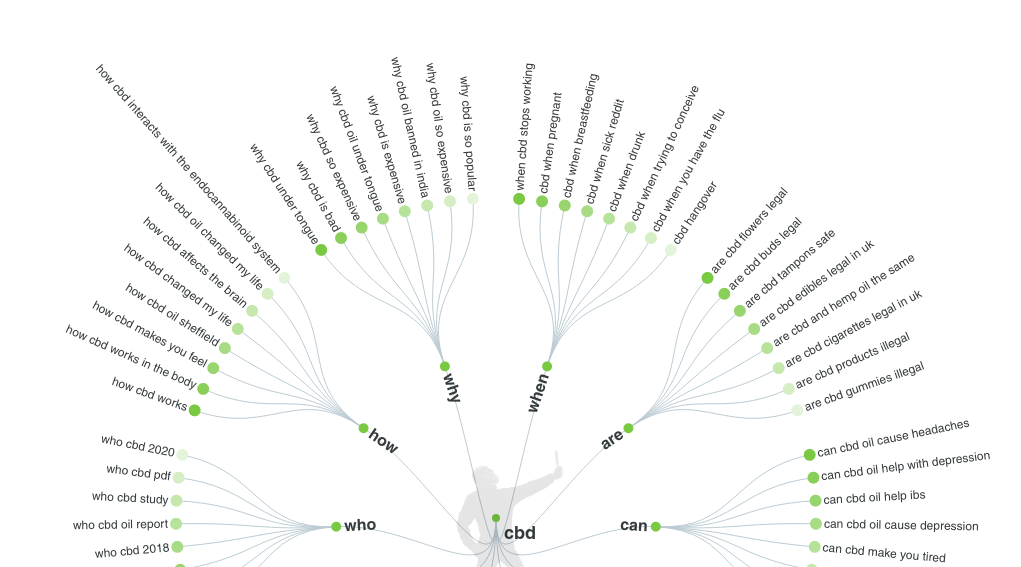
For instance, I searched for CBD on Answer the Public and got the result above.
9. Finally, create content
After analyzing, researching, and making market reports, it’s time to create content.
Once you have listed the relevant titles, the first step would be to check if there’s already some previously written content available. You can evaluate such content and see what your target audience has been talking about or their reaction to it.
You must keep your target audience in mind and write in a voice that suits your audience and aligns with your brand.
For instance, to build a friendly rapport with your customers, use a warm tone and give it a personal touch. Whereas, if you want to educate your customers and come up as a serious brand, using a professional and formal tone would be better.
The content should be in an easy-to-understand language. If you are writing scientific articles targeting a specific niche of a knowledgeable audience, then only you should use technical or scientific terms. Otherwise, keep it simple and avoid jargon and technical terms.
It’s best to divide your content into- the introduction, body, and conclusion. Using headings, subheadings, and bullet points would make it easier for readers to understand and for Google to crawl through it.
Also, you must keep the SEO factors in mind. Your content should be optimized for search engines or precise for Google. Ensure that you do not do keyword stuffing but use them wisely.
At the same time, make sure that your content is informative and valuable for your target audience. The content should be purposeful and leave readers with a clear call to action.
10. Market your content
Now that your content is ready, it’s time to proofread it. Your Content marketing team should have an editor or a proofreader that will check all content for facts, grammar, and authenticity.
Once the proofreading team approves the content, it’s time to publish it.
Revisit your content calendar and check where and when you had scheduled to publish this particular piece of content.
Whether you publish it as an e-book or on your blog, you need to have a strategy to promote it once it’s live.
Make sure all your content is shareable. You can share it with influencers who can further engage an audience that might find it informative and valuable. Another way to place your content in front of a relevant audience is through email marketing.
Tools like Missinglettr can help promote your content on auto-pilot mode through drip campaigns.
Another tool that can help you promote content is OptinMonster.
11. Evaluate outcomes
With so much effort put into the entire process, now is the time to evaluate the results. At this point, I’d like you to go back to point number 2, where you defined your KPIs, i.e., the Key performance indicators.
Use tools like google analytics to measure how successful your efforts have been.
Monitoring your performance would help you find the most compelling content and the content that failed to click the audience’s interest. This information would help you create better content in the future and increase your chances of success.
It is essential to lay down the correct and achievable KPIs to justify this last step.
Wrapping Up
Creating a killer content marketing strategy isn’t a walk in the park. It takes determination, time, effort, and consistency to successfully strategize and implement the plan. But with team effort and proper planning, this will be worthwhile.
With a documented content marketing plan, you will be directing your business for long-term achievement.